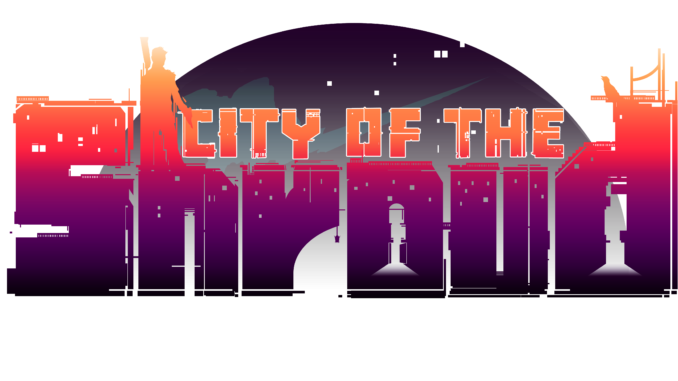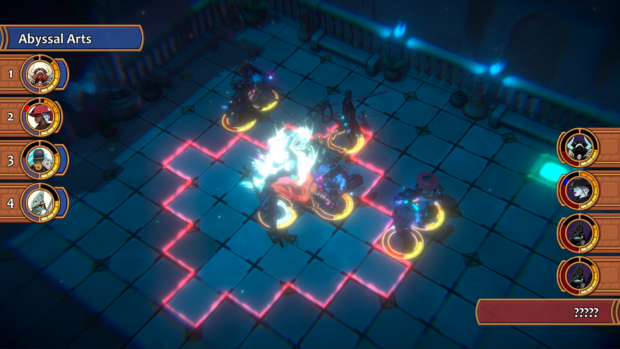
Review Fix chats with Keaton White, Founder of Abyssal Arts, who discusses his new tactical RPG, “City of the Shroud,†detailing its origin, his departure from Capcom and why gamers should give it a shot.
Review Fix: How was this game born?
Keaton White: Everything started back in 2014 after I left Capcom Japan, where I had been working as a Production Manager for about 4 years. My partner and I were moving to England for her work and so I could attempt developing a game.
I was thinking about what kind of game to make and was feeling nostalgic for games like Final Fantasy Tactics and Vanguard Bandits, so I went back to play Final Fantasy Tactics and just couldn’t handle the pacing anymore. To me, it now felt too slow and cumbersome to play, and so I started thinking about how to make a tactical game that was more exciting, which led me to think about fighting games. I thought, what if we could adapt elements from a much faster-paced type of mental strategy to change how a tactical game could play? What would that look like? How would it play? What elements would you adopt, and which would you change or remove?
My background was in production and managing art teams, with no programming, art creation, music, writing, etc., experience to speak of, so I reached out to two friends from college – Moira Katson and Ryan Becker. Moira’s writing career was well on its way, with the successful release of her Light & Shadow trilogy (along with other titles), and Ryan had recently finished a degree in game design. I got in touch, asked them if they wanted to make a game, and they said yes – and that was more or less how it all got started.
A lot has happened between then and now, we’ve been joined by others along the way, and we’ve all learned an enormous amount. If you had told us what the game would be like now vs then, I don’t think we would have believed you!

Review Fix: Why do RPGs still matter?
White: I don’t think RPGs have ever stopped mattering. They may not always be at the top of the best-seller chart, but there’s an incredible appeal in living out epic stories, and the level of imagination they allow developers to unleash is hard to match.
They also allow for an incredible amount of variety in their gameplay, since what most people would, I think, consider the base structure of the player(s) improving across the arc of a story in order to achieve a goal, is very flexible and can be adapted to all sorts of gameplay styles.
I’m not good at metaphors, but maybe it’s like a spice when cooking? You could base dishes around it, you could sprinkle it into something it wouldn’t normally go in to create a unique kick, you could leave it out entirely, or you could dump the whole bottle in and completely overwhelm someone’s palate (and every palate is different, so maybe it’s a better metaphor than I thought). There are infinite ways to use it, and sometimes it’ll be popular and sometimes it won’t, but it’ll always be there, inspiring people or giving them something that they’re looking for and can’t find anywhere else.
Review Fix: How do you improve upon and play with the formula?
White: For our game, we started out by building online multiplayer prototypes with cubes on a height-varied grid. We wanted multiplayer, and we figured that, since it was hard, we would do it first so that we knew how to deal with it, and so that we could play against each other to test ideas. This meant that we wouldn’t have to iterate on AI to discover if our concepts were fun. Instead, if we could play against each other, we could find and iterate on our best ideas faster.
We started with basic ideas for movement and attacking, implemented them, and immediately threw them out because they were terrible. So we came up with new ideas, built them, and kept what (few) things worked. We did this over and over and over.
No turns? Fastest clicker wins. Shared stamina? Too easy to rely on a single character. Letting characters overspend for massive combos that would leave them vulnerable while recovering? Game-breaking. And so on.
It was when we hit on the early form of the current combo system that things started to fall into place. Taking inspiration from games like Legend of Legaia, we gave each character moves that were activated using specific inputs. Now we had layers of depth – not only did you need to think about your moves and what effects they had, but how they interacted with your ability to use them.
Maybe you really like a certain move, but it doesn’t combine well with other abilities. Is it worth equipping it anyway, or should you prioritize being able to chain together as many things as possible?
When we set it so that you decided on your equipped moves before going into battle (a-la Pokémon), it created a lot of strategies to consider outside of a fight, while letting you focus on just using moves and their effects during combat.
From there, we simply worked out different classes and moves we thought would add depth and fun to allow for a variety of play styles. We wanted players to be able to set up their teams as they saw fit, so we just kept working to make a wide variety of abilities that work together in all sorts of unique ways.
[embedyt] https://www.youtube.com/watch?v=dS6pFzP_7qg[/embedyt]
Review Fix: What was development like?
White: Development was done entirely remotely. I was in England, where I met many of our collaborators in fields we couldn’t cover ourselves – from our composer, Chris Nairn, to sound effects design, UI and environment design, programming support, promotional art, 3D environment art, and so on.
For the core team, Moira and Ryan were based in the US, along with Grant Barber, who built and manages the backend systems that let us all work together.
And in Japan, we had Samogon Studios doing our 2D art and concepts, and Jon Slabaugh, another friend from college, handling our backend needs.
We all worked together via git, messaging apps, regular meetings (even with time differences!), and the very rare face-to-face get-together wherever possible. We had to be very good at communicating what we were working on, how we wanted or needed something to happen, and when we had done something.
This is where my production background came in handy – I took what I had been doing at Capcom with massive teams and budgets and applied it to indie development. In addition to our core team, we worked with friends who helped us as freelancers, studios with whom I had worked while at Capcom, and with folks who had been recommended by other developers. Without that prior experience, this would have been a much more daunting task.
To cover the cost of doing this, we ran a small but successful Kickstarter, and I did contract work as a freelance translator (Japanese to English) to make up the majority of the budget. In doing so, I was able to handle the translations for both The Legend of Zelda Encyclopedia and The Legend of Zelda: Breath of the Wild—Creating a Champion, so as a lifelong Zelda fan, that was both cool and highly educational from a design perspective.
Overall, it was a long, slow, steady development process. It was massively challenging, not least because of how far apart we all are. But every time we showed off an updated version of the game, the feedback got better, players were more excited, and we felt a rush of inspiration and enthusiasm. Hopefully next time we’ll have a bit more flexibility, though!

Review Fix: What makes this game special?
White: There are two major elements of the game I’m most proud of: our player-driven narrative, and our combat system.
Being able to interact with the players and have them directly influence how we forge the game’s story is really exciting and inspiring for us. We don’t know what they’re going to do – and that’s part of the fun. It’s a daunting task, but because we’re smaller, and treating our ability to look at numbers and stats and use them qualitatively as a strength, we think it’ll lead to a truly unique experience for all of us.
I’m also very proud of our combat system. It’s a major departure from… most other combat systems, even if we are referencing some very tried-and-true mechanics. It creates a tactical experience that has a great action feel that I’m still enjoying thousands of hours later. Watching players experience it for the first time and shows and getting really into it has been extremely rewarding, and I think it gives the game an identity all its own.
Review Fix: What games influenced this one the most?
White: From my perspective, Legend of Legaia, Final Fantasy Tactics, and even titles like Final Fantasy XIV played a big role in how this game came together. Shadow Hearts II deserves an honorable mention as well.
Most of the games I played growing up were Japanese console titles – mostly RPGs and action games. Moira drew a lot of inspiration from games like Mass Effect, and Ryan has a lot of experience with Western PC games like Diablo and Civilization. That said, our personal libraries overlap fairly heavily, so even if we started from polar opposite design concepts, it was fairly easy to work towards something that we were both familiar with and had enjoyed in other games.
Review Fix: Any fun stories or wild moments during development?
White: I’m happy to report that nothing too crazy happened during development – at least in terms of things catching on fire. Still, across the team we’ve:
- Built a booth using bags of sand and shoelace
- Carried posters bigger than we are and entire PC setups home on cramped trains and replacement buses through freezing cold
- Had a production baby
- Moved countries – twice
- Got engaged
- And more!
Everyone on the team has had their own exciting moments, but I’m really glad that they’re either positive events for team members personally or dumb things I brought on myself to help save money!

Review Fix: Do you think preserving older gameplay mechanics in new games is important?
White: Absolutely! There is a goldmine of interesting ideas in older games that can serve as inspiration for new ideas or help solve present design challenges. As an example, I wouldn’t necessarily recommend someone recreate the control scheme from Mega Man Legends, but going back and playing that title and its sequel is a good demonstration of how control schemes evolved as 3D gameplay became more mature, how simple but well-designed content can be engaging even 20 years later, and how different world design can dramatically affect a game’s mechanics and sense of progression.
When I think of a design idea and feel like I’ve seen something similar before, I’ll go looking for reference material to see how similar ideas have been executed before, and, if I can, experience it directly by playing the game.
That process may not be for everyone, but I find older games to be a great resource.
Review Fix: What’s your favorite memory as a gamer?
White: The year Twilight Princess came out, my family got snowed in and spent most of the Christmas holiday trapped inside the house. I probably would have done this anyway, but I got and played Twilight Princess almost non-stop (when the power was up). My brother would sit nearby and watch.
We were arguing a lot around that time, but Twilight Princess held our attention and gave us something to do together. He would provide navigation support and general enthusiasm while I worked my way through the dungeons.
We were playing late into the night one night and got to Argorok, the Twilit Dragon. That boss fight has you slinging around pillars in the sky dodging fireballs while trying to latch onto the enraged dragon’s back as a storm brews around you. It was 1:30 in the morning, the music was blasting, our minds were blown by the sense of the scale of the fight, and we were out-and-out shouting. I mean, full on, losing-our-minds shouting.
Turns out, shouting in the middle of the night wakes people up. My dad came out and told us to quiet down, so we tried to shout less, but we were so excited. We did everything we could to stifle our excitement, but when I finally beat the boss, we couldn’t hold it in anymore, let out one final victory cry (my brother was practically doing a victory dance), and crashed into bed.

Review Fix: Who will enjoy this game the most?
White: Players who enjoy an emphasis on story and narrative development, as well as players who are looking for a faster-paced tactical experience.
We’ve also included the ability to pause the game at any moment to issue orders, as well as adjust game speed, so you do have the option to play at whatever pace you choose!
If you enjoy RPGs with engaging narratives, I think you’ll like City of the Shroud.
Review Fix: Bottom Line, why must someone play this game?
White: City of the Shroud boasts a unique, player-driven story system, and an explosive, one-of-a-kind combat system!
If engaging stories and exciting gameplay are your thing, you should definitely check out City of the Shroud.
 Review Fix: How do you want this game to be remembered?
White: As a good game! More seriously, I hope that people enjoy our narrative and gameplay experiments and that what we’re doing helps lead to more exploration of how developers and players can craft worlds together – it’s a unique capability of our medium, and I’m excited to keep exploring it.Â
Review Fix: What’s next?
White: Rest, and then we start on Chapter Two! We’ll take a breather once Chapter One is out while players influence the game world, and then we’ll get to work on Chapter Two.
Beyond future chapters, we’ll look at the game’s reception and start thinking about what we can do from there!


Leave a Reply